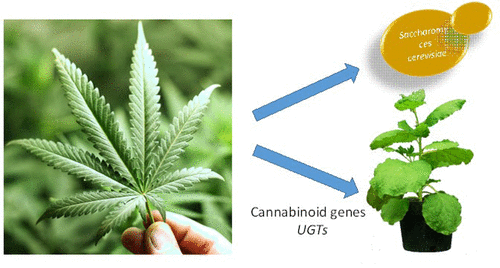当前位置:
X-MOL 学术
›
J. Nat. Prod.
›
论文详情
Our official English website, www.x-mol.net, welcomes your
feedback! (Note: you will need to create a separate account there.)
Synthetic Biology of Cannabinoids and Cannabinoid Glucosides in Nicotiana benthamiana and Saccharomyces cerevisiae
Journal of Natural Products ( IF 3.3 ) Pub Date : 2020-10-01 , DOI: 10.1021/acs.jnatprod.0c00241 Thies Gülck 1 , J K Booth 2 , Â Carvalho 3 , B Khakimov 4 , C Crocoll 5 , M S Motawia 1 , B L Møller 1, 5 , J Bohlmann 2 , N J Gallage 1, 6
Journal of Natural Products ( IF 3.3 ) Pub Date : 2020-10-01 , DOI: 10.1021/acs.jnatprod.0c00241 Thies Gülck 1 , J K Booth 2 , Â Carvalho 3 , B Khakimov 4 , C Crocoll 5 , M S Motawia 1 , B L Møller 1, 5 , J Bohlmann 2 , N J Gallage 1, 6
Affiliation

|
Phytocannabinoids are a group of plant-derived metabolites that display a wide range of psychoactive as well as health-promoting effects. The production of pharmaceutically relevant cannabinoids relies on extraction and purification from cannabis (Cannabis sativa) plants yielding the major constituents, Δ9-tetrahydrocannabinol and cannabidiol. Heterologous biosynthesis of cannabinoids in Nicotiana benthamiana or Saccharomyces cerevisiae may provide cost-efficient and rapid future production platforms to acquire pure and high quantities of both the major and the rare cannabinoids as well as novel derivatives. Here, we used a meta-transcriptomic analysis of cannabis to identify genes for aromatic prenyltransferases of the UbiA superfamily and chalcone isomerase-like (CHIL) proteins. Among the aromatic prenyltransferases, CsaPT4 showed CBGAS activity in both N. benthamiana and S. cerevisiae. Coexpression of selected CsaPT pairs and of CHIL proteins encoding genes with CsaPT4 did not affect CBGAS catalytic efficiency. In a screen of different plant UDP-glycosyltransferases, Stevia rebaudiana SrUGT71E1 and Oryza sativa OsUGT5 were found to glucosylate olivetolic acid, cannabigerolic acid, and Δ9-tetrahydrocannabinolic acid. Metabolic engineering of N. benthamiana for production of cannabinoids revealed intrinsic glucosylation of olivetolic acid and cannabigerolic acid. S. cerevisiae was engineered to produce olivetolic acid glucoside and cannabigerolic acid glucoside.
中文翻译:

本塞姆氏烟草和酿酒酵母中大麻素和大麻素糖苷的合成生物学
植物大麻素是一组植物来源的代谢物,具有广泛的精神活性和促进健康的作用。药用相关大麻素的生产依赖于从大麻 ( Cannabis sativa ) 植物中提取和纯化,产生主要成分 Δ 9 -四氢大麻酚和大麻二酚。在本塞姆氏烟草或酿酒酵母中异源生物合成大麻素可能会提供具有成本效益且快速的未来生产平台,以获得纯且大量的主要和稀有大麻素以及新型衍生物。在这里,我们使用大麻的宏转录组分析来鉴定 UbiA 超家族的芳香异戊二烯基转移酶和查耳酮异构酶样 (CHIL) 蛋白的基因。在芳香族异戊烯基转移酶中, Cs aPT4 在本塞姆氏烟草和酿酒酵母中都显示出 CBGAS 活性。选定的Cs aPT 对和 CHIL 蛋白编码基因与CsaPT4的共表达不会影响 CBGAS 催化效率。在对不同植物 UDP-糖基转移酶的筛选中,发现甜叶菊 Sr UGT71E1 和稻 Os UGT5 能够将橄榄叶酸、大麻二酚酸和 Δ 9 -四氢大麻酸进行葡萄糖基化。用于生产大麻素的本塞姆氏烟草的代谢工程揭示了橄榄叶酸和大麻二酚酸的内在糖基化。酿酒酵母经过改造可生产橄榄酸葡萄糖苷和大麻二酚酸葡萄糖苷。
更新日期:2020-10-26
中文翻译:

本塞姆氏烟草和酿酒酵母中大麻素和大麻素糖苷的合成生物学
植物大麻素是一组植物来源的代谢物,具有广泛的精神活性和促进健康的作用。药用相关大麻素的生产依赖于从大麻 ( Cannabis sativa ) 植物中提取和纯化,产生主要成分 Δ 9 -四氢大麻酚和大麻二酚。在本塞姆氏烟草或酿酒酵母中异源生物合成大麻素可能会提供具有成本效益且快速的未来生产平台,以获得纯且大量的主要和稀有大麻素以及新型衍生物。在这里,我们使用大麻的宏转录组分析来鉴定 UbiA 超家族的芳香异戊二烯基转移酶和查耳酮异构酶样 (CHIL) 蛋白的基因。在芳香族异戊烯基转移酶中, Cs aPT4 在本塞姆氏烟草和酿酒酵母中都显示出 CBGAS 活性。选定的Cs aPT 对和 CHIL 蛋白编码基因与CsaPT4的共表达不会影响 CBGAS 催化效率。在对不同植物 UDP-糖基转移酶的筛选中,发现甜叶菊 Sr UGT71E1 和稻 Os UGT5 能够将橄榄叶酸、大麻二酚酸和 Δ 9 -四氢大麻酸进行葡萄糖基化。用于生产大麻素的本塞姆氏烟草的代谢工程揭示了橄榄叶酸和大麻二酚酸的内在糖基化。酿酒酵母经过改造可生产橄榄酸葡萄糖苷和大麻二酚酸葡萄糖苷。










































 京公网安备 11010802027423号
京公网安备 11010802027423号